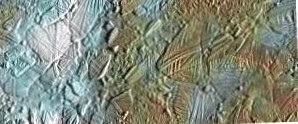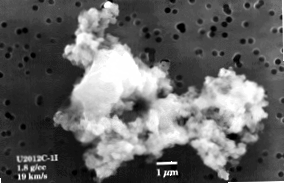Two American scientists believe that complex life arises from a subtle, rarely encountered interplay of many factors
It is one of the most crude, unanswered questions: Are we alone in space?? Are humans the only intelligent life form in the universe? Peter D. Ward does not believe it. "The universe and even our Milky Way are so vast that there must be other intelligent life forms", says the geoscientist from the University of Washington in Seattle. "I think it is impossible that we are alone."
Ward was all the more puzzled when he read the blurb of the book he co-authored with astronomer Donald Brownlee of the same university. "Maybe we are really alone", it said – a phrase that earned the publisher’s editor an angry phone call from Ward. "We were very careful to avoid exactly this statement", he explains. "We don’t think we’re alone."

Ice on Jupiter’s moon Europa
Publishers love trenchant statements and provocative theses. They are always more sales-demanding than carefully weighing, materially founded arguments, as they are valued among scientists. But "Our lonely earth" by Ward and Brownlee is anything but a quick-fix aimed at quick commercialization, but a basic assessment of the abundance of complex, possibly intelligent life in space. For this purpose, the two researchers evaluated a large number of new findings from the relatively young, interdisciplinary research field of astrobiology.
The chances of finding life outside the earth have been rated higher again for some years. After the landing of the Viking probes on Mars in 1976, which could not prove any traces of life, things had looked quite different. The hopes of discovering even one bacterium outside the earth tended towards zero.

Interplanetary dust
But little by little a new picture emerged. Thus astronomers could prove in the year 1995 for the first time a planet outside of our solar system. In the meantime, more than 60 such "extrasolar" The existence of organic matter on comets and in interstellar dust clouds is considered by some researchers to be the waste products of living organisms. Earth-like celestial bodies that could have caused life forms to evolve have not yet been identified, though. However, their existence is considered more and more probable.
In addition to potential breeding grounds of life, its chemical building blocks seem to be quite widespread in space. Some researchers even consider the organic matter detected on comets and in interstellar dust clouds to be waste products of living beings. "About a third of the carbon found there", says Chandra Wickramasinghe, a mathematician and astronomer at the University of Wales in Cardiff, "occurs in the form of molecules that cannot be distinguished from bacterial matter. So far, it has not been satisfactorily explained how these substances are supposed to have been created in an inorganic, non-biological way."
In addition to carbon, liquid water is considered an essential prerequisite for the emergence and development of life. Here, too, space explorers have found life outside the Earth: On Mars as well as on the Jupiter moon Europa the indications of water occurrences have consolidated, although the last proof is still pending. In particular, Europe enveloped in a thick crust of ice captures the imagination of researchers: "I do not doubt it", says Wickramasinghe, "that we will discover there under the ice surface an ocean that probably harbors not only microbes but also more complex life forms similar to our fish."
Asteroid Gaspra
Ward and Brownlee do not want to go that far. Ward concedes: "There are good reasons to look for life on Mars or Jupiter’s moon Europa. We have gained many new insights into extremophiles, organisms that exist in extreme, actually hostile environments." But this is only true for primitive life. For complex, multicellular organisms, on the other hand, Ward and Brownlee see poor chances of.
Image of the Martian meteorite ALH84001
Until now, the distribution of life itself has appeared to be a decisive factor in the so-called Drake equation, which is used to estimate the frequency of highly developed, contact-ready civilizations: Evidence of primitive life forms automatically increased the likelihood of encountering intelligent life forms. This is exactly what Ward and Brownlee doubt. They suspect that simple, bacterial life is widespread in space. But whether it also develops into complex forms of life depends on the right conditions. "We believe that the number of planets that have such conditions over a long enough period of time has been overestimated. The evolution of complex life forms requires very stable conditions over very long periods of time, which are extremely rare."
The Drake equation
In the fifties, the American astronomer Frank Drake developed a formula to estimate how many civilizations exist in our Milky Way. This number is obtained by multiplying the number of stars in the Milky Way (about 200 to 300 billion) by
Still at the beginning of the eighties the astronomer Carl Sagan estimated on the basis of this formula the number of the communication-ready civilizations alone in the Milky Way to several millions. In the opinion of Peter D. Ward and Donald Brownlee think this is much too high. They criticize at these treasures above all the underlying amption that where life develops, also almost inevitably higher and higher life forms develop: The number of planets where this is possible could be far smaller than previously amed.
For example, life on earth existed for over two billion years in the form of single-celled organisms. Only half a billion to a billion years ago the transition to multicellular organisms took place. According to Ward and Brownlee, in order for there to be sufficient stability over such a long period of time, a number of conditions must be met. The energy output of the parent star must not vary too much, which excludes many stars. The planetary system must be located in a certain region of the galaxy, not too close to the center, where the radiation exposure is too high, but also not too far to the edge, because there too few of the heavy elements necessary for the formation of terrestrial planets are produced.
Not too much, but also not too little – the emergence of complex life appears to Ward and Brownlee as a result of a very fine tuning of many ingredients, which only rarely succeeds. For example carbon: Without it there can be no life according to the present state of knowledge. But too much carbon can in turn lead to an atmospheric greenhouse effect that suffocates all life. Thus, the two scientists come to the conclusion that the Earth is a very special planet.
We may not be alone in space, but we may be very lonely. Is it worthwhile to continue searching for signals of extraterrestrial intelligence?? "We should continue the search", says Ward. "But at the same time we should be aware that we may never leave this planet and reach other star systems. So we should take very, very good care of the place of our origin."
Peter D. Ward / Donald Brownlee: Our Lonely Earth – Why Complex Life in the Universe is Unlikely. Springer Publishing House. 376 S. 26 Abb., 2 tab. Geb. 3-540-41365-0. DM 49,90.-